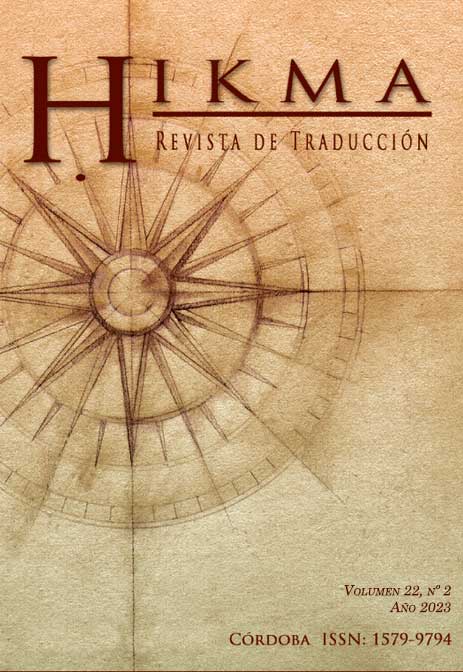SPOTURNO, María Laura (coord.). Subjetividad, discurso y traducción: La construcción del ethos en la escritura y la traducción. Valladolid, Ediciones Universidad de Valladolid, 2022, 217 pp., ISBN 978-84-1320-197-9
Main Article Content
Abstract
Book review: SPOTURNO, María Laura (coord.). Subjetividad, discurso y traducción: La construcción del ethos en la escritura y la traducción. Valladolid, Ediciones Universidad de Valladolid, 2022, 217 pp., ISBN 978-84-1320-197-9
Downloads
Article Details

This work is licensed under a Creative Commons Attribution-NonCommercial-ShareAlike 4.0 International License.
Authors who publish with this journal agree to the following terms:
1. Authors retain copyright and grant the journal right of first publication with the work simultaneously licensed under a Creative Commons Attribution License that allows others to share the work with an acknowledgement of the work's authorship and initial publication in this journal.
2. Authors are able to enter into separate, additional contractual arrangements for the non-exclusive distribution of the journal's published version of the work (e.g., post it to an institutional repository or publish it in a book), with an acknowledgement of its initial publication in this journal.
3. Authors are permitted and encouraged to post their work online (e.g., in institutional repositories or on their website) prior to and during the submission process, as it can lead to productive exchanges, as well as earlier and greater citation of published work (See The Effect of Open Access).
References
Amossy, R. (Ed.). (1999). Images de soi dans le discours. La construction de l’ethos. Delachaux et Niestlé.
Amossy, R. (2009). La double nature de l’image d’auteur. Argumentation et Analyse du Discours, 3, 1-13. https://doi.org/10.4000/aad.662
Amossy, R. (2010). La présentation de soi, Ethos et identité verbale. PUF. https://doi.org/10.3917/puf.amoss.2010.01
Amossy, R. (2021). Qu’est-ce que l’ethos collectif ? En R. Amossy y E. Orkibi (Eds.), Ethos collectif et identités sociales (pp. 21-52). Classiques Garnier.
Aristóteles (1990). Retórica. Introducción, traducción y notas por Quintín Racionero. Gredos.
Benveniste, É. (1966). Problèmes de linguistique générale 1. Gallimard. https://edisciplinas.usp.br/pluginfile.php/3711724/mod_resource/content/1/PLG.pdf
Bonnafous, S. (2002). La question de l’ethos et du genre en communication politique. Actes du premier colloque franco-mexicain des sciences de la communication (pp. 35-1).
Cabezón Cámara, G. (2017). Las aventuras de la China Iron. Literatura Random House.
Cabezón Cámara, G. (2019). The Adventures of China Iron (Trads. Iona Macintyre y Fiona Mackintosh). Charco Press.
Charaudeau, P. (2005). Le discours politique. Les masques du pouvoir. Vuibert.
Crenshaw Williams, K. (1989). Demarginalizing the Intersection of Race and Sex: A Black Feminist Critique of Antidiscrimination Doctrine, Feminist Theory and Antiracist Politics (pp. 139-167) University of Chicago Legal Forum.
Ducrot, O. (1984). Le dire et le dit. Minuit.
Grana, R. (2012). Construir la identidad: el ethos del orador. Línguas e Instrumentos Linguísticos 27, 85-104 https://ri.conicet.gov.ar/handle/11336/69275
Greimas, A. J. y Courtès J. (1976). The cognitive dimension of narrative discourse. New Literary History, 7(3), 433-447. https://doi.org/10.2307/468554
Hermans, T. (2014). Positioning translators: Voices, views and values in translation. Language and Literature, 23(3), 285-301. https://doi.org/10.1177%2F0963947014536508
Hernández, J. (1872). El gaucho Martín fierro. Imprenta de La Pampa.
Lozano, J., Peña-Marín, C. y Abril, G. (1982). Análisis del discurso. Hacia una semiótica de la interacción textual. Cátedra.
Maingueneau, D. (1999). Ethos, scénographie, incorporation. En R. Amossy (Ed.), Images de soi dans le discours. La construction de l’ethos (pp.75-100). Delachaux et Niestlé.
Maingueneau, D. (2002). Problèmes d’ethos. Pratiques, 113/114, 55-67. https://doi.org/10.3406/prati.2002.1945
Maingueneau, D. (2014). Le recours à l’ethos dans l’analyse du discours littéraire. Fabula / Les colloques, Posture d’auteurs : du Moyen Âge à la modernité. http://www.fabula.org/colloques/document2424.php
Maingueneau, D. (2015). Escritor e imagen de autor. (Trad. Carole Gouaillier). Tropelías. Revista de Teoría de la Literatura y Literatura Comparada, 24, 17-30. https://doi.org/10.26754/ojs_tropelias/trope lias.2015241139
Moraga, C. y Anzaldúa, G. E. (1981). This bridge colled my back. State University of New York Press.
Moraga, C. y Castillo, A. (Eds.) (1988). Esta puente, mi espalda: Voces de mujeres tercermundistas en los Estados Unidos (Trad. de Ana Castillo y Norma Alarcón). ism Press / Editorial ismo.
Spoturno, M. L. (2017). The presence and image of the translator in narrative discourse: towards a definition of the translator’s ethos. Moderna Språk, 113(1), 173-196.
Spoturno, M. L. (2019). El retrabajo del ethos en el discurso autotraducido. El caso de Rosario Ferré. Hermēneus, 21, 323-354. https://doi.org/10.24197/her.21.2019.323-354
Spoturno, M. L. (2022). Ethos colectivo, redes de lucha y prácticas de escritura y (auto)traducción en colaboración: el caso de Revenge of the Apple / Venganza de la manzana, de Alicia Partnoy. Letral, 28, 46-72. https://doi.org /10.30827/rl.vi28.21366
Suchet, M. (2010). Textes hétérolingues et textes traduits : de « la langue » aux figures de l’énonciation. Pour une littérature comparée différentielle. [Tesis doctoral. Montreal, Universidad de Concordia]. https://spectrum.library.concordia.ca/id/eprint/7445/1/Suchet-PhD-S2011.pdf
Suchet, M. (2013). Voice, tone and ethos: a portrait of the translator as a spokesperson. En K. Taivalkoski-Shilov y M. Suchet (Eds.), La traduction des voix intra-textuelles / Intratextual voices in translation (pp. 159-184). Les Éditions québécoises de l'œuvre.
Suchet, M. (2014). L’Imaginaire hétérolingue. Classiques Garnier.

